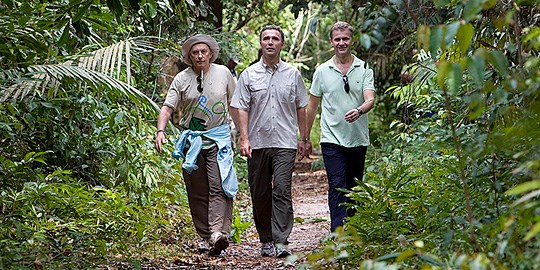Saving the rainforest in Brazil can save Norwegian glaciers
Historical archive
Published under: Stoltenberg's 2nd Government
Publisher: Office of the Prime Minister
News story | Date: 19/09/2008
“It is an extraordinary experience to be in the Brazilian rainforest and travel by boat along the Amazon River. If we are able to stop deforestation in Brazil, we can also manage to save Norwegian glaciers,” says Prime Minister Jens Stoltenberg.
“It is an extraordinary experience to be in the Brazilian rainforest and travel by boat along the Amazon River. If we are able to stop deforestation in Brazil, we can also manage to save Norwegian glaciers,” says Prime Minister Jens Stoltenberg.
Mr Stoltenberg visited the Brazilian rainforest on Wednesday, together with Minister of the Environment and International Development Erik Solheim and Brazil’s Minister of the Environment Carlos Minc. They all spent the night on a boat on the Amazon, sleeping in hammocks, before making their expedition into the rainforest on Wednesday morning.
Norway has decided to allocate up to USD one billion to the Brazilian Amazon Fund, for reducing deforestation in the Amazon, during the period leading up to 2015.
“No other country has come as far as Brazil when it comes to monitoring and preserving the rainforest. It is therefore crucial that we cooperate closely with Brazil,” says Minister of the Environment and Development Erik Solheim.

Mr Stoltenberg visited the Brazilian rainforest on Wednesday, together with Minister of the Environment and International Development Erik Solheim (right) and Brazil’s Minister of the Environment Carlos Minc (left). Photo: Scanpix.
The local community of Jamaraquá, which Mr Stoltenberg and Mr Solheim visited on Wednesday, has around 9000 inhabitants. It is located in the nature reserve on the eastern side of the river Tapajós, the National Forest of Tapajós. This is not a conventional nature reserve, but a protected area where traditional groups have certain rights to engage in business activities.
Here, the Norwegian delegation was able to see small-scale business based on rubber manufacture and locally-crafted products. A single narrow path runs through the forest, which quite literally forms a wall on either side and seems impenetrable.
Jamaraquá is located at the heart of the vast Brazilian rainforest. The river Tapajós is a tributary of the Amazon, and was key to enabling settlement of this region. A number of indigenous groups lived along the banks of the river. Because of the isolated location, life here remained largely unchanged right up until the 1960s, when outsiders began to move into the rainforest.
The newcomers brought with them cattle farming and gold mining, conflicts with the indigenous peoples, and environmental degradation on a huge scale. In order to ease the conflicts and take better care of the environment, the authorities have established a number of protected areas of various kinds in the Amazon.
The National Forest of Tapajós on the eastern side of the river has been divided into several smaller areas intended for different kinds of use. Some areas are used for small-scale farming of various kinds, for instance, while others are completely protected.
The Prime Minister is currently travelling in Latin America, where he is visiting Brazil and Chile. The trip reflects the increasingly close cooperation between Norway and the two Latin American countries.